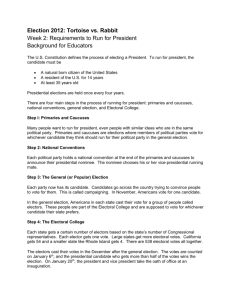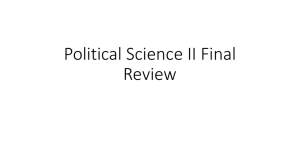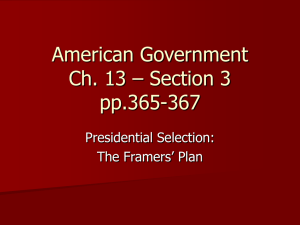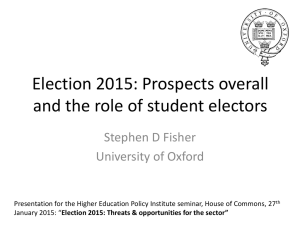DOES MY VOTE COUNT? A presentation on the electoral
advertisement
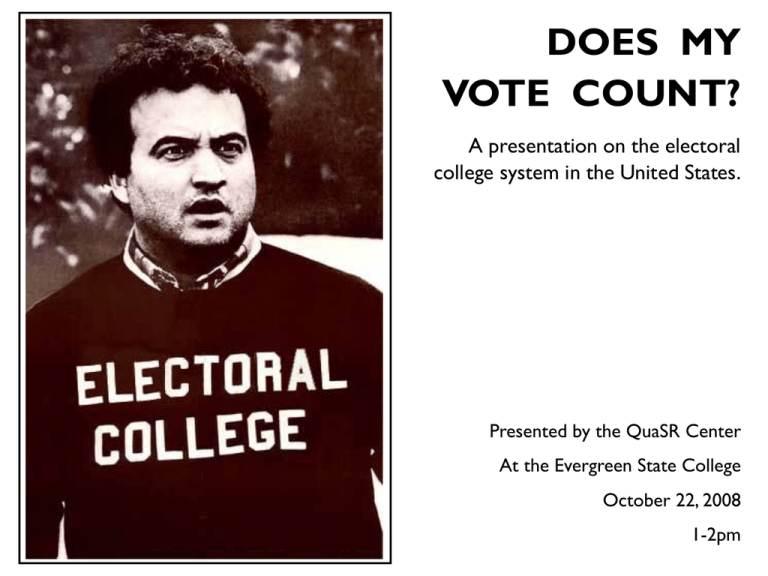
DOES MY VOTE COUNT? A presentation on the electoral college system in the United States. Presented by the QuaSR Center At the Evergreen State College October 22, 2008 1-2pm The President of the United States is chosen by…….. a. A secret ballot, without debate, by the federal convention, a body established solely for that purpose. b. A popular vote from the general election held the Tuesday after the first Monday of November of an election year. c. The House of Representatives. d. A body of 538 party-affiliate appointed and chosen representatives. e. Two separate elections, the first being a free-for-all followed by a second round between the top two finishers. What is the electoral college? 538 electors chosen by state to represent their pledged political party. Note that 538 is 0.0000178% of the current US population of 305,115,689 Electors are chosen by their political party as a reward for service. Each state is allocated a number of electors equal to the number of senators (always two) plus the number of its representatives. The results from the November general election dictate which political party’s electors are chosen to vote in the electoral college in December. The electoral college election process was established…. a. as a result of early church-based election practices in colonial times. b. because the average American is too ignorant to be trusted to elect the president. c. by the founding fathers as a compromise between election of the president by Congress and election by popular vote d. to give power to the governing body and make it easier to put the “right” person in office. e. as a buffer against democratic control, a way of taking our chief executive out of the hands of the common man and giving to an enlightened few. History Founders started electoral The Electoral College was established by the founders as a compromise between election for the president by Congress and election by popular vote. Alexander Hamilton was among the first to write about the concept of electors in the Federalist Papers in 1788. The electoral college assumed its present constitutional form in 1804. The similarities between the Electoral College and classical institutions are not accidental. Many of the Founding Fathers were well schooled in ancient history and its lessons. The structure of the Electoral College can be traced to the Centurial Assembly system of the Roman Republic. How does it work? Nationally Locally (Wa) 1. State Primaries are held 2. Each party nominates a top candidate 3. National conventions are held 4. In November each state holds a general election 5. Parties’ pool of electors are chosen 6. The electoral college votes in December. 7. The President is inaugurated Who are the Electors? Depending on State policy, electors are nominated by their political party, voted for in the primaries or chosen by a campaign committee Currently, all states choose electors by popular election on the date specified by federal law Electors can be anyone from a housewife to a lawyer to a baseball player No person holding a federal office, either elected or appointed, may become an elector Phases in the Presidential Election Process 1) Pre-nomination 2) National Conventions 3) General Election 4) Electoral College Election 2000 election highlighted Why 2000? US Census year Pivotal election Highly contentious Sparked interest in the electoral college Nader issue Florida 2000 Population Density 100% Republican 100% Democrat . . . . • • Green Party candidate Ralph Nader received 2,882,728 votes, but no Electoral Votes One of only 4 elections, and first in over 100 years (1824, 1876, 1888, 2000) where the popular vote winner was defeated Population Density & Party Dominance Apportionment of Electoral Votes 50 40 20 10 0 Washington 30 Major issues in apportionment: Overseas citizens -Military -Missionaries -Other Illegal immigrants in the census Census updates population totals once every decade Cap on the number of seats in the House of Representatives Voter turnout: Election Voting Age Population Turnout % Turnout of VAP 2004 215,694,000 122,295,345 56.69% 2000 205,815,000 105,586,274 51.31% 1996 196,511,000 96,456,345 49.08% 1992 189,529,000 104,405,155 55.09% 1988 182,778,000 91,594,693 50.11% 1984 174,466,000 92,652,680 53.11% 1980 164,597,000 86,515,221 52.56% 1976 152,309,190 81,555,789 53.55% 1972 140,776,000 77,718,554 55.21% 1968 120,328,186 73,199,998 60.83% 1964 114,090,000 70,644,592 60.92% 1960 109,159,000 68,838,204 63.06% Poor voters (0-16th percentile) Lower-mid income voters (17-33rd percentile) Middle income voters (34-66th percentile) Upper-mid income voters (67-95th percentile) High income voters (95-100th percentile) States “won” by the Republican and Democratic party, based on estimated vote preferences and economic status. In favor of the Electoral College: 92% record of non-controversial results Promotes an ideologically and geographically broad two-party system Contributes to the cohesiveness of the country by requiring a distribution of popular support to be elected president Enhances the status of minority interests Maintains a federal system of government and representation Against the Electoral College: The possibility of electing a minority president (one that did not receive the popular vote) The risk of so-called “faithless electors” The possible role of the electoral college in depressing voter turnout Its failure to accurately reflect the national popular will Census only occurs once every 10 years Proposals made to change the system: Over the past 200 years, over 700 proposals have been introduced in Congress to reform or eliminate the Electoral College Several joint resolutions were introduced in the current Congress and were referred to the Committee on the Judiciary. The proposals include the following: Voting rights for residents of the United States territories and commonwealths [H.J.RES.2.IH] Direct election of the President and Vice President by the popular vote [H.J.RES.36.IH] Right to vote amendment [H.J.RES.28.IH] Every Vote Counts amendment [H.J.RES.4.IH] Alternative Systems: Direct Election with Instant Runoff Voting Congressional District Method Proportional Allocation of Electoral Votes National Bonus Plan Direct Vote with Plurality Rule Binding Proposal Does my vote count? YES!!! Since the party-affiliate electors are chosen to vote for the popular vote decided by the state, YOUR vote counts to increase the popular vote for your party! If there are enough people in your party that vote and win the popular vote, all the party-affiliated electoral votes will go to your candidate!



